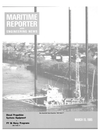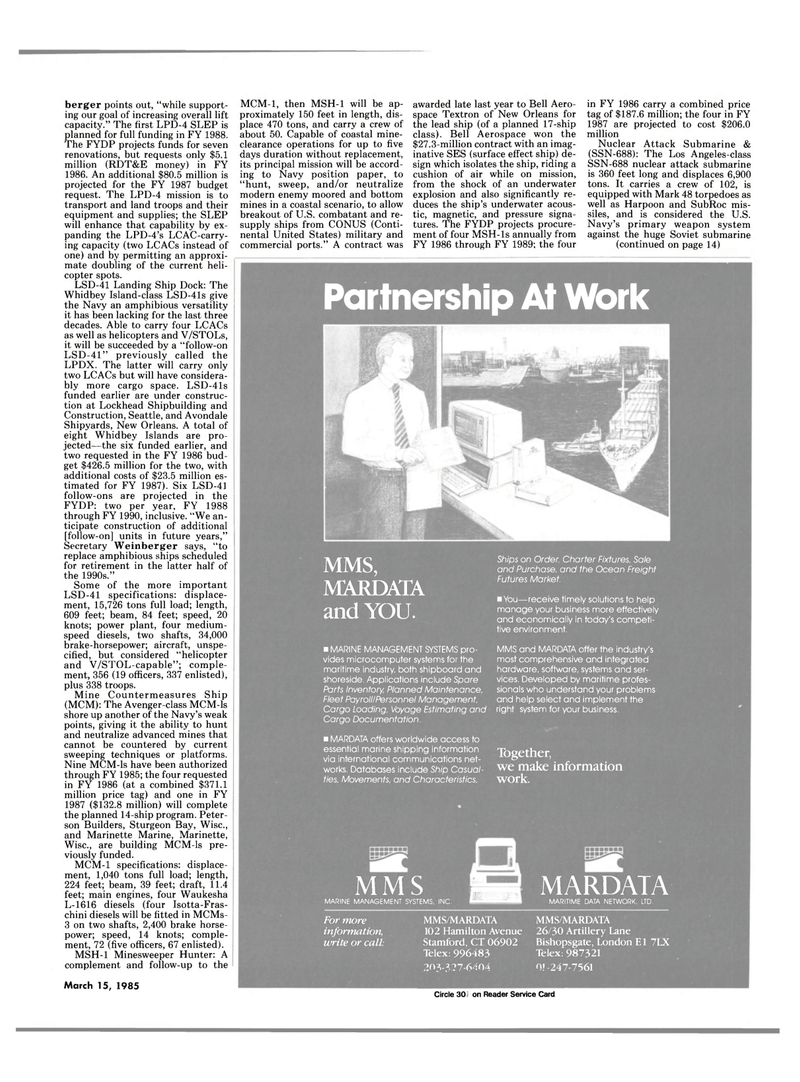
Page 11: of Maritime Reporter Magazine (March 15, 1985)
Read this page in Pdf, Flash or Html5 edition of March 15, 1985 Maritime Reporter Magazine
berger points out, "while support- ing our goal of increasing overall lift capacity." The first LPD-4 SLEP is planned for full funding in FY 1988.
The FYDP projects funds for seven renovations, but requests only $5.1 million (RDT&E money) in FY 1986. An additional $80.5 million is projected for the FY 1987 budget request. The LPD-4 mission is to transport and land troops and their equipment and supplies; the SLEP will enhance that capability by ex- panding the LPD-4's LCAC-carry- ing capacity (two LCACs instead of one) and by permitting an approxi- mate doubling of the current heli- copter spots.
LSD-41 Landing Ship Dock: The
Whidbey Island-class LSD-41s give the Navy an amphibious versatility it has been lacking for the last three decades. Able to carry four LCACs as well as helicopters and V/STOLs, it will be succeeded by a "follow-on
LSD-41" previously called the
LPDX. The latter will carry only two LCACs but will have considera- bly more cargo space. LSD-41s funded earlier are under construc- tion at Lockhead Shipbuilding and
Construction, Seattle, and Avondale
Shipyards, New Orleans. A total of eight Whidbey Islands are pro- jected—the six funded earlier, and two requested in the FY 1986 bud- get $426.5 million for the two, with additional costs of $23.5 million es- timated for FY 1987). Six LSD-41 follow-ons are projected in the
FYDP: two per year, FY 1988 through FY 1990, inclusive. "We an- ticipate construction of additional [follow-on] units in future years,"
Secretary Weinberger says, "to replace amphibious ships scheduled for retirement in the latter half of the 1990s."
Some of the more important
LSD-41 specifications: displace- ment, 15,726 tons full load; length, 609 feet; beam, 84 feet; speed, 20 knots; power plant, four medium- speed diesels, two shafts, 34,000 brake-horsepower; aircraft, unspe- cified, but considered "helicopter and V/STOL-capable"; comple- ment, 356 (19 officers, 337 enlisted), plus 338 troops.
Mine Countermeasures Ship (MCM): The Avenger-class MCM-ls shore up another of the Navy's weak points, giving it the ability to hunt and neutralize advanced mines that cannot be countered by current sweeping techniques or platforms.
Nine MCM-ls have been authorized through FY 1985; the four requested in FY 1986 (at a combined $371.1 million price tag) and one in FY 1987 ($132.8 million) will complete the planned 14-ship program. Peter- son Builders, Sturgeon Bay, Wise., and Marinette Marine, Marinette,
Wise., are building MCM-ls pre- viously funded.
MCM-1 specifications: displace- ment, 1,040 tons full load; length, 224 feet; beam, 39 feet; draft, 11.4 feet; main engines, four Waukesha
L-1616 diesels (four Isotta-Fras- chini diesels will be fitted in MCMs- 3 on two shafts, 2,400 brake horse- power; speed, 14 knots; comple- ment, 72 (five officers, 67 enlisted).
MSH-1 Minesweeper Hunter: A complement and follow-up to the
MCM-1, then MSH-1 will be ap- proximately 150 feet in length, dis- place 470 tons, and carry a crew of about 50. Capable of coastal mine- clearance operations for up to five days duration without replacement, its principal mission will be accord- ing to Navy position paper, to "hunt, sweep, and/or neutralize modern enemy moored and bottom mines in a coastal scenario, to allow breakout of U.S. combatant and re- supply ships from CONUS (Conti- nental United States) military and commercial ports." A contract was awarded late last year to Bell Aero- space Textron of New Orleans for the lead ship (of a planned 17-ship class). Bell Aerospace won the $27.3-million contract with an imag- inative SES (surface effect ship) de- sign which isolates the ship, riding a cushion of air while on mission, from the shock of an underwater explosion and also significantly re- duces the ship's underwater acous- tic, magnetic, and pressure signa- tures. The FYDP projects procure- ment of four MSH-ls annually from
FY 1986 through FY 1989; the four in FY 1986 carry a combined price tag of $187.6 million; the four in FY 1987 are projected to cost $206.0 million
Nuclear Attack Submarine & (SSN-688): The Los Angeles-class
SSN-688 nuclear attack submarine is 360 feet long and displaces 6,900 tons. It carries a crew of 102, is equipped with Mark 48 torpedoes as well as Harpoon and SubRoc mis- siles, and is considered the U.S.
Navy's primary weapon system against the huge Soviet submarine (continued on page 14)
Partnership At Work
MMS,
MARDATA and YOU. • MARINE MANAGEMENT SYSTEMS pro- vides microcomputer systems for the maritime industry, both shipboard and shoreside. Applications include Spare
Parts Inventory, Planned Maintenance,
Fleet Payroll/Personnel Management
Cargo Loading, Voyage Estimating and
Cargo Documentation. • MARDATA offers worldwide access to essential marine shipping information via international communications net- works. Databases include Ship Casual- ties, Movements, and Characteristics,
Ships on Order, Charter Fixtures, Sale and Purchase, and the Ocean Freight
Futures Market. • You—receive timely solutions to help manage your business more effectively and economically in today's competi- tive environment.
MMS and MARDATA offer the industry's most comprehensive and integrated hardware, software, systems and ser- vices. Developed by maritime profes- sionals who understand your problems and help select and implement the right system for your business.
Together, we make information work.
MMS
MARINE MANAGEMENT SYSTEMS, INC.
MARDATA
MARITIME DATA NETWORK, LTD.
For more MMS/MARDATA MMS/MARDATA information, 102 Hamilton Avenue 26/30 Artillery Lane write or call: Stamford, CT 06902 Bishopsgate, London E1 7LX
Telex: 996483 Telex: 987321 203-377-6404 0! -247-7561
March 15, 1985 13
Circle 350 on Reader Service Card

 10
10

 12
12
